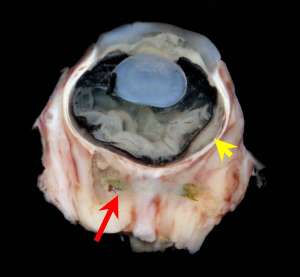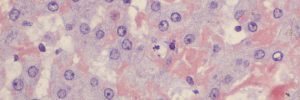Retrobulbar grass seed in a dog
A 2-year-old male English Springer Spaniel presented with a 4-week history of intermittent unilateral pain, swelling, redness and purulent discharge affecting the left eye.

Final Diagnosis
Retrobulbar grass seed migration associated with choroidal abscessation and endophthalmitis
Discussion
These grass seeds typically enter the orbit either via migration from behind the third eyelid, through the conjunctiva or via the oral cavity. Given enough time, the majority will penetrate the posterior sclera and enter the globe. Large bacterial colonies are frequently embedded within the foreign plant material and a suppurative endophthalmitis typically ensues.

